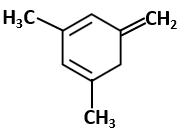HCl with an alkene X reacts in accordance with Markovnikov’s rule to give 1-Chloro-1-methylcyclohexane. The structure of alkene (X) is:
| 1. |  |
2. |  |
| 3. | (1) and (2) | 4. |  |
2,3-dimethyl-2-butene can be prepared by heating which of the following compounds with a strong acid?
1.
2.
3.
4.
The reaction of C6H5CH =CHCH3 with HBr produces:
| 1. | \(C_{6} H_{5} \underset{Br}{\underset{\left|\right.}{CH}} CH_{2} CH_{3} \) |
| 2. | \(C_{6} H_{5} CH_{2} \underset{Br}{\underset{\left|\right.}{CH}} CH_{3} \) |
| 3. | \(C_{6} H_{5} CH_{2} CH_{2} CH_{2} Br \) |
| 4. |  |
When subjected to ozonolysis, which compound results in the formation of the given molecule?
| 1. |  |
2. |  |
| 3. |  |
4. |  |
Given compounds are as follows:
| (I) |  |
(II) |  |
| (III) |  |
The enthalpy of hydrogenation of these compounds will be in the order as-
| 1. | I > II > III | 2. | III > II > I |
| 3. | II > III > I | 4. | II > I > III |
Which of the following organic compounds has same hybridization as its combustion product –(CO2)?
1. Ethane
2. Ethyne
3. Ethene
4. Ethanol
| 1. |  |
2. |  |
| 3. |  |
4. |  |
The reagent that can be used to distinguish between 1-butyne and 2-butyne is:
1. \(\mathrm{HCl}\)
2. \(\mathrm{O_{2}}\)
3. \(\mathrm{B r_{2}}\)
4. \(\mathrm{N a N H_{2}}\)
|
Given below is a reaction sequence: |
| 1. |  |
| 2. |  |
| 3. |  |
| 4. |  |
Liquid hydrocarbons can be converted to a mixture of gaseous hydrocarbons by:
1. Oxidation
2. Cracking
3. Distillation under reduced pressure
4. Hydrolysis







